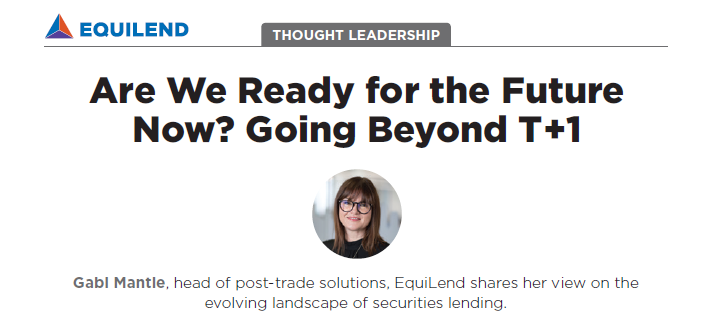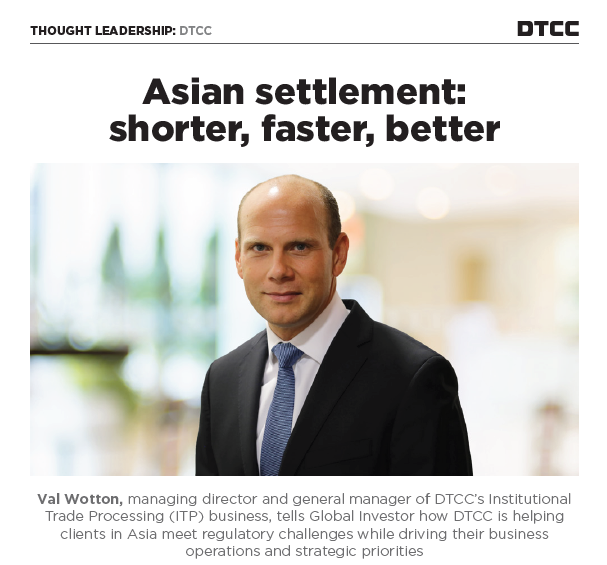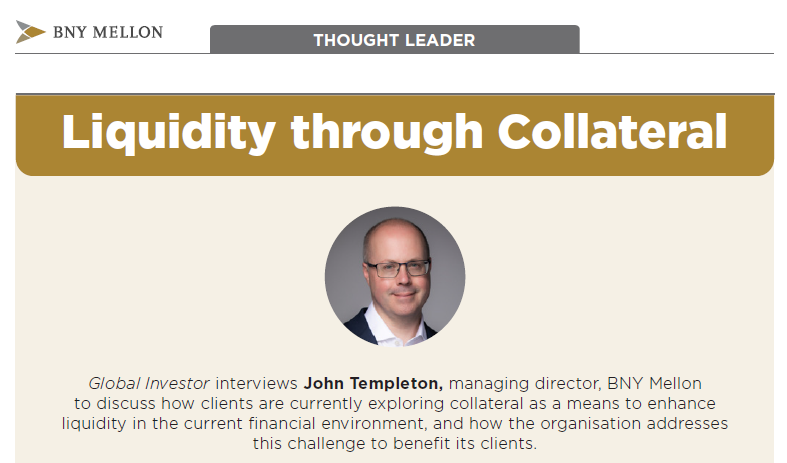Are We Ready for the Future Now? Going Beyond T+1

Are We Ready for the Future Now? Going Beyond T+1
Gabi Mantle, head of post-trade solutions at EquiLend, shares her view on the evolving landscape of securities lending.
This article is part of the 2023 Americas Securities Finance Guide, which can be accessed here.
The securities finance landscape is currently one of shifting sands, but this storm of change has been blowing for many years. There is little that hasn’t been subject to adaptation with the advancement of regulation, the demand for standardisation, and requirements for interoperability, each of which impacts the day-to-day business of creating liquidity for financial markets.
Regulators are taking the long view, with efficient markets the end goal. To get there, both iterative and big bang changes will be necessary.
EquiLend has been in the business of change for improvement – over change for the sake of change – for a long time, which gives us confidence in the power of the revolution being ushered in with the latest regulatory storm.
Requirements for the future
The SEC’s vision for US markets has created a runway of advancement as trade settlement cycles have been gradually reduced, most recently with the move from T+3 to T+2 in 2017. The latest SEC initiatives impacting the securities lending markets are the 10c-1 proposal, which would require reporting trade status within 15 minutes after the securities loan is effected or the terms of the loan are modified, and T+1, which further reduces the settlement cycle from two days to one, both of which suppose a speed of execution which is only possible with automation.
A clear view of exactly the current status of the trade, all day, every day, on both sides of the trade, is possible with the right investment in automated technology combined with real-time data capabilities to support firms in contributing to efficient markets and be compliant with regulation.
Efficient technology delivers on T+1, and even T+0 – something EquiLend is already in a position to support. Automation at the point of trade removes the significant risk of human error and reduces the weight on managing exceptions in post-trade; furthermore, automation throughout the loan lifecycle (specifically returns, recalls, collateral management, SSIs and prematching) all help to reduce the operational burden of manual processing or fixing exceptions.
Let’s face it, there simply won’t be time to waste on manual processing, correcting errors or validating data points; it is the adoption of automated solutions which will make or break T+1 – or the perhaps foregone conclusion of an eventual T+0 settlement cycle.
Every forward step on the path to T+1 is a leap into the future of the sector. Every element of a transaction must move more quickly and more accurately to comply, from research to execution to the subsequent operational activities of a trade. Market colour as up-to-the-minute as possible—such as real-time data available through DataLend—becomes essential.
Manually negotiated and hand-keyed transactions eat up precious time in a one-day settlement cycle and heighten the risk of human error, rendering the old way of chats and emails counterproductive at best and ineffectual at worst.
A majority of the market benefits from automated execution on NGT, of course, with Competitive Bid, Equilend’s latest trading innovation, enabling automation of warms and specials coupled with real-time market data, NGT transaction information and post-trade data points all in one place to ensure a clarity of view and an efficiency of process unprecedented in the industry.
Once executed, all transactions pass through post-trade lifecycle events - once manual to process, cumbersome to navigate and prone to error - all of which now can be seamlessly managed via EquiLend’s robust suite of post-trade solutions.
The reality of large-scale change will always have some casualties, regardless of the preparation. Taking some learnings from CSDR, where we saw returns volumes increase by 35% in the three months post-enforcement, it is fair to assume there will be additional pressure on posttrade mechanisms as firms get comfortable with the tighter framework for trade settlement.
Going beyond T+1
The move to T+1 has already been made by India, moving trades to the new timeline incrementally – loading the least-traded stocks onto the new protocol and adding new trades weekly to minimise impact. The US and Canada, which intends to switch to T+1 one day before the US, will go for the big bang, committing virtually all trades to the T+1 settlement cycle from 27 May 2024 and 28 May 2024 respectively. The near-time learnings from India’s adoption of T+1, such as a short-term increase in settlement failure and misalignment of cut-off times generating higher margin calls, has had some impact for adjacent markets in APAC.
These factors will be important to note for North America’s 2024 switch and integral to a move by European markets to T+1, which is certainly on the horizon. EU T+1 taskforce meetings are already in place, and the final report is expected by the end of 2023, so it’s now a case of when and not if. T+1 ushers in a new era, pushing the envelope of change. Those first-adopter firms who have embraced on-platform execution and embedded, automated post-trade processes are already well prepared for T+1.
The human nature of caution in the face of extraordinary change will have to be overcome given the brief timeline given for compliance with the shortened cycle. Yet the infrastructure is available today for immediate compliance. Even T+0 will be a soft-sell proposition when fully supported by DeFi tech such as EquiLend 1Source. Underpinned by distributed ledger technology, EquiLend 1Source brings lifecycle information on a centralised chain, keeping both sides of a transaction in sync at all times and eliminating the need for reconciliations altogether. This is the type of future-proofing innovative firms are doing today.
Ultimately, the technology required for a perfect day one for T+1 entails efficient, on-platform trading, automated post-trade processes and clean data viewable across multiple touchpoints throughout the trade lifecycle, further enhanced by real-time data. This is not a pipe dream, but an ecosystem available now with EquiLend. The firms that have their sights set on a day - perhaps not far off - where T+0 is the norm are best positioned for the shift coming less than a year from now.
Found this useful?
Take a complimentary trial of the FOW Marketing Intelligence Platform – the comprehensive source of news and analysis across the buy- and sell- side.
Gain access to:
- A single source of in-depth news, insight and analysis across Asset Management, Securities Finance, Custody, Fund Services and Derivatives
- Our interactive database, optimized to enable you to summarise data and build graphs outlining market activity
- Exclusive whitepapers, supplements and industry analysis curated and published by Futures & Options World
- Breaking news, daily and weekly alerts on the markets most relevant to you




